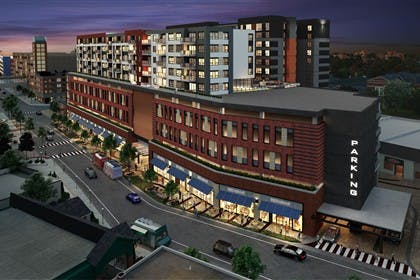Building demolition along Grand River Avenue in downtown East Lansing began last week for the anticipated construction of the new Center City District development project, which is the two 12-story mixed-use buildings that will include apartments and a new Target retail location.
The development is being constructed as part of something called a Tax Increment Financing plan, or TIF, which redirects a percentage of property taxes earned by the city on that property back to the developer to reimburse the company for construction costs, specifically on construction of public utilities.
The agreement that sets up a TIF is known as a brownfield plan.
But with East Lansing still in debt —enough debt to potentially result in cuts to city services — how will this new project impact the city’s finances?
Tim Dempsey, East Lansing’s director of Planning, Building and Development, said that the city will not be losing money on the Center City development.
In fact, the city will be making money from the project.
“All the taxes that we capture currently in that development area are going to continue to be received by the city,” Dempsey said. “We don’t forgo any of that, we continue to capture all those taxes. It’s only the new value that is redirected into the project.”
According to Dempsey, the developers must pay a yearly $200,000 ground lease payment for the site where the building is taking place, in addition to various other payments to the city and the Downtown Development Authority.
There is also a one-time fee of $600,000 paid to the city for the construction of water and sewer connections for the new property.
According to City Manager George Lahanas, the amount of money that the city makes from the development annually will be “as much as four to $500,000, but those are really estimates at this point.”
Dempsey gave an estimate of around $422,000 in revenue per year.
“Essentially its an equivalent to what the property would’ve generated in tax revenue,” Dempsey said. “However, the brownfield funds are primarily being utilized primarily to pay for the parking structure, which the city will own.”
The TIF plan in this specific instance covers the construction of the new parking garage at the Center City site that will replace the Albert Avenue lot that is currently being demolished.
Lahanas said the parking garage will provide additional revenue to the city once it is completed.
According to the Center City Master Development Agreement, available on the City of East Lansing website, the total amount of money that the developer will be reimbursed through the brownfield plan is around $58 million over the 19-year TIF, which begins in 2020.
That includes taxes for the City of East Lansing, Ingham County public schools, CATA, the airport authority, and other entities.
Dempsey said that the recent failure of the East Lansing income tax proposal in the Nov. 7 municipal election would not have any impact on the Center City plans.
“No income tax revenue was projected to be utilized for this project,” Dempsey said. “This project was structured prior to that income tax, and it doesn’t change at all. The only difference is that the income tax had proposed lowering the city property tax millage, which would’ve reduced some of the Tax Increment Financing revenue, but since that failed, that won’t have an impact.”
But the question remains: ultimately, will the Center City project help the city financially?
"We certainly hope so," Altmann said. "When you factor in second-order benefits, it's a little harder to quantify."
He explained that with an influx of new residents living in the buildings, there will be an influx of money into the downtown area. In addition, the senior housing in the Center City development will expand the demographics of downtown.
Support student media!
Please consider donating to The State News and help fund the future of journalism.
They're gonna live there, they're gonna spend money there," he said.
Altamann also suggested that as more investment comes to downtown, the area may become attractive for developers looking to build office space.
"Increasing density in an urban environment is good," Atlmann said. "There's a better climate for businesses."
Discussion
Share and discuss “How Center City will impact the city's financial situation” on social media.







